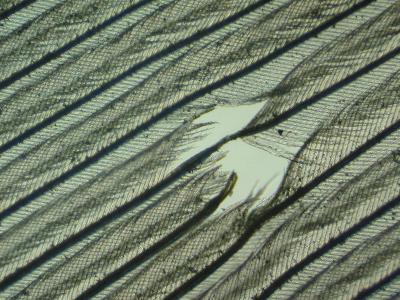|
Feather Hole
Feather holes often characteristically occur on wing and tail feathers of some small-bodied species of passerines. In the case of barn swallows, it was suggested that the holes were feeding traces of avian lice, either ''Machaerilaemus malleus'' and/or ''Myrsidea rustica'' (both Phthiraptera: Amblycera). Hole counts were shown to be highly repeatable, and thus counts appeared to be useful measures to quantify the intensity of infestation. Since then, a number of influential papers have been published on the evolutionary, ecological, and behavioral aspects of host-parasite interactions based on the assumption that holes were chewed by ''Machaerilaemus malleus''. More specifically, host sexual selection, feather breakage, flight performance, immunity levels, arrival dates, and even song characteristics were shown to covary with the number of holes. Cross-fostering experiments showed that infestation levels were heritable. Recently, however, it was shown that ''Machaerilaemus malleus ... [...More Info...] [...Related Items...] OR: [Wikipedia] [Google] [Baidu] |
Feather Hole
Feather holes often characteristically occur on wing and tail feathers of some small-bodied species of passerines. In the case of barn swallows, it was suggested that the holes were feeding traces of avian lice, either ''Machaerilaemus malleus'' and/or ''Myrsidea rustica'' (both Phthiraptera: Amblycera). Hole counts were shown to be highly repeatable, and thus counts appeared to be useful measures to quantify the intensity of infestation. Since then, a number of influential papers have been published on the evolutionary, ecological, and behavioral aspects of host-parasite interactions based on the assumption that holes were chewed by ''Machaerilaemus malleus''. More specifically, host sexual selection, feather breakage, flight performance, immunity levels, arrival dates, and even song characteristics were shown to covary with the number of holes. Cross-fostering experiments showed that infestation levels were heritable. Recently, however, it was shown that ''Machaerilaemus malleus ... [...More Info...] [...Related Items...] OR: [Wikipedia] [Google] [Baidu] |
Feather
Feathers are epidermal growths that form a distinctive outer covering, or plumage, on both avian (bird) and some non-avian dinosaurs and other archosaurs. They are the most complex integumentary structures found in vertebrates and a premier example of a complex evolutionary novelty. They are among the characteristics that distinguish the extant birds from other living groups. Although feathers cover most of the bird's body, they arise only from certain well-defined tracts on the skin. They aid in flight, thermal insulation, and waterproofing. In addition, coloration helps in communication and protection. Plumology (or plumage science) is the name for the science that is associated with the study of feathers. Feathers have a number of utilitarian, cultural, and religious uses. Feathers are both soft and excellent at trapping heat; thus, they are sometimes used in high-class bedding, especially pillows, blankets, and mattresses. They are also used as filling for winter cloth ... [...More Info...] [...Related Items...] OR: [Wikipedia] [Google] [Baidu] |
Passerines
A passerine () is any bird of the order Passeriformes (; from Latin 'sparrow' and '-shaped'), which includes more than half of all bird species. Sometimes known as perching birds, passerines are distinguished from other orders of birds by the arrangement of their toes (three pointing forward and one back), which facilitates perching. With more than 140 families and some 6,500 identified species, Passeriformes is the largest clade of birds and among the most diverse clades of terrestrial vertebrates, representing 60% of birds.Ericson, P.G.P. et al. (2003Evolution, biogeography, and patterns of diversification in passerine birds ''J. Avian Biol'', 34:3–15.Selvatti, A.P. et al. (2015"A Paleogene origin for crown passerines and the diversification of the Oscines in the New World" ''Molecular Phylogenetics and Evolution'', 88:1–15. Passerines are divided into three clades: Acanthisitti (New Zealand wrens), Tyranni (suboscines), and Passeri (oscines or songbirds). The passerin ... [...More Info...] [...Related Items...] OR: [Wikipedia] [Google] [Baidu] |
Barn Swallow
The barn swallow (''Hirundo rustica'') is the most widespread species of swallow in the world. In fact, it appears to have the largest natural distribution of any of the world's passerines, ranging over 251 million square kilometres globally. It is a distinctive passerine bird with blue upperparts and a long, deeply forked tail. It is found in Europe, Asia, Africa and the Americas. In Anglophone Europe it is just called the swallow; in northern Europe it is the only common species called a "swallow" rather than a "martin". There are six subspecies of barn swallow, which breed across the Northern Hemisphere. Four are strongly migratory, and their wintering grounds cover much of the Southern Hemisphere as far south as central Argentina, the Cape Province of South Africa, and northern Australia. Its huge range means that the barn swallow is not endangered, although there may be local population declines due to specific threats. The barn swallow is a bird of open country that nor ... [...More Info...] [...Related Items...] OR: [Wikipedia] [Google] [Baidu] |
Lice
Louse ( : lice) is the common name for any member of the clade Phthiraptera, which contains nearly 5,000 species of wingless parasitic insects. Phthiraptera has variously been recognized as an order, infraorder, or a parvorder, as a result of developments in phylogenetic research. Lice are obligate parasites, living externally on warm-blooded hosts which include every species of bird and mammal, except for monotremes, pangolins, and bats. Lice are vectors of diseases such as typhus. Chewing lice live among the hairs or feathers of their host and feed on skin and debris, while sucking lice pierce the host's skin and feed on blood and other secretions. They usually spend their whole life on a single host, cementing their eggs, called nits, to hairs or feathers. The eggs hatch into nymphs, which moult three times before becoming fully grown, a process that takes about four weeks. Genetic evidence indicates that lice are a highly modified lineage of Psocoptera (now called Ps ... [...More Info...] [...Related Items...] OR: [Wikipedia] [Google] [Baidu] |




